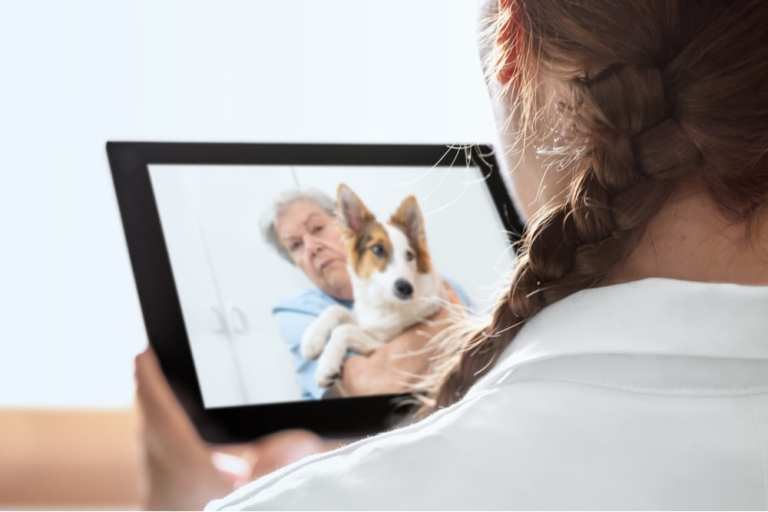How Telemedicine Is Going To The Dogs (And Cats, Too)

Pet care, no surprise, is big business.
In the U.S. alone, pet owners spent $29 billion on veterinary care and product sales, as estimated by the American Pet Products Association. That tally includes routine vet care, surgical procedures and pharmaceuticals.
And while all manner of businesses shut down during the pandemic, veterinarians proved to be essential — and, along with the rest of us, have been pivoting to embrace the great digital shift.
And in an interview with Karen Webster, Steven Carter, CEO of online platform TeleVet said that telemedicine has a growing place in the pet care space — chiefly as a means to keep patients and providers in communication about animals’ health, and as a way to keep practices running smoothly.
In years past, he said, “very few people thought telemedicine would be a staple of veterinary practices. But fast forward to today and you can’t go to a veterinary conference without hearing five chats on telemedicine. Its usage has gone through the roof.”
At a high level, the TeleVet platform brings veterinarians and pet owners across two types of services: virtual consultations and follow-up appointments.
The company traces its genesis to five years ago when it focused on selling and caring for horses online. Carter likened the original model to a “CarMax for horses.”
Carter said the model has shifted since then (in breadth of services rendered for large and small animal care) with the realization that telemedicine had untapped potential in veterinary medicine.
 In terms of mechanics, the TeleVet app integrates with vets’ offices (6,500 practices are using the platform, he said) through web or mobile conduits — fostering communications between pet “parents” and vet offices through text, phone calls or video chats.
In terms of mechanics, the TeleVet app integrates with vets’ offices (6,500 practices are using the platform, he said) through web or mobile conduits — fostering communications between pet “parents” and vet offices through text, phone calls or video chats.
To preserve a continuity of care, medical records and video chats can be uploaded to the clinics’ practice management systems. The app also processes payments and deposits money directly into the clinics’ accounts, and vets can set their own pricing for various services rendered via teleconference.
Carter noted that charging for services through the app remains a significant value proposition for the vets themselves. As he told Webster: “While we entered the [telemed] space based purely on owner convenience, what we quickly realized was that there were some real challenges for the veterinarians.”
The providers were spending significant amounts of time on consultations, giving healthcare advice essentially for free and tipping their work-life balance decidedly toward work.
“We had vets telling us they were doing 20 of these consultations a day, but they weren’t charging for them.”
As TeleVet has helped introduce a “pay as you go” model, he said, vets can charge for follow ups and new consultations.
The platform model, he said, also helps make sure that follow-up appointments are set (and that owners follow through).
Follow-up appointments, said Carter, are critical means of ensuring that medication or treatments prescribed are working properly.
A 15-minute video consultation, for example, can determine that a lesion is healing properly, while in-person visits can focus on more labor intensive (and, for the vet, lucrative) services, such as teeth cleaning. In the end, said Carter, vets find that their practices become more efficient through telemed.
There are still some hurdles to be considered as telemedicine takes root in the pet care space, said Carter, particularly surrounding the veterinary-client-patient relationship (or VCPR).
“A lot of pet owners don’t realize that to receive medications and a diagnosis, remotely, through telemedicine or any platform, just about every state mandates that vets or practices have had to have seen your pet in person before,” he said.
Looking Ahead
Looking ahead, TeleVet intends to roll out a subscription model in the near term. Carter said his firm would be examining how to create savings accounts and help match programs through Teladoc (the virtual healthcare company) to encourage pet parents to plan ahead and save money for pet care.
The shift to telemedicine as a key conduit for pet care is likely to be permanent, according to Carter. He noted that roughly two-thirds of pet owners are millennials — whose spending power is on the rise, and who are used to getting services on demand, aided by technology.
“The demographics of today’s pet owner are largely aligned with digital services, and that’s been in place even before [the] coronavirus,” Carter told Webster. “The coronavirus has just accelerated the shift even faster.”